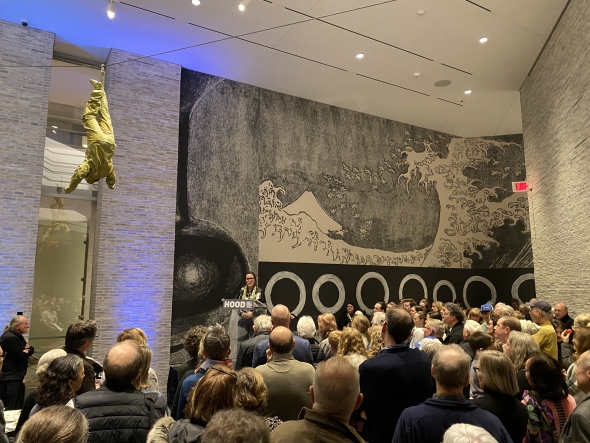
An Exhibit Opening at the Hood
The Hood Museum of Art is Dartmouth's center for all things exhibition-related in the visual arts. With a large gallery space and one of the most extensive collections in the country, the Hood Museum—or "Hood" for short—provides students with unparalleled opportunities to learn about the creative process of artists, the act of displaying art, and understanding the meaning of art.
On a cold winter evening last week, I attended an opening by the photographer Cara Romero titled Panûpünüwüga, or Living Light. Romero is a renowned artist of the Chemehuevi tribe, and her work is widely recognized for exploring Native American and Indigenous experiences. I saw the event listed in a Hood email newsletter, and given that the exhibition is planned to run until mid-August, I knew this would be my chance to hear directly from the artist. When I arrived, the space was packed—everyone from students to local alumni to faculty and staff were present.
The opening reception began with remarks by President Beilock, followed by a statement from the curator, Jamie Powell, and finally, words from Cara Romero herself. What I took away from the statements was that Dartmouth is actively making efforts to expand its Native American art collection, and this exhibition was the culmination of an intensive collaboration between the Hood, Romero, and other Indigenous artists. Additionally, the Hood is hosting Romero's biggest show to date, setting a precedent for future Native American art exhibitions.

The exhibit itself spanned across a main gallery in the Hood and extended to a second level upstairs. Each photograph was intriguing and led me to consider how she pursued her photography practice. Romero used unique angles, perspectives, and timing in conjunction with digital editing to create powerful images that transcend normal photography. Her technique, combined with her thematic focus on the histories and lives of Indigenous peoples, made the exhibition more profound in its ability to prompt reflection in the viewer. As mentioned in a press release from the Hood, "this exhibition presents a thematic examination of Romero's complex and layered images, which celebrate the multiplicity, beauty, and resilience of Native American Art and Indigenous experiences."
Overall, the opening was another amazing opportunity to learn about the art world up close and personal—how exhibition openings function, how curation occurs, and how collaborative work between artists, curators, and museums can lead to artistic progress. I will be on the lookout for future exhibit openings, but in the meantime, I can keep busy through all the other ways the Hood engages students—including the museum club, a student-led collecting program, and seminars by visiting artists.

















